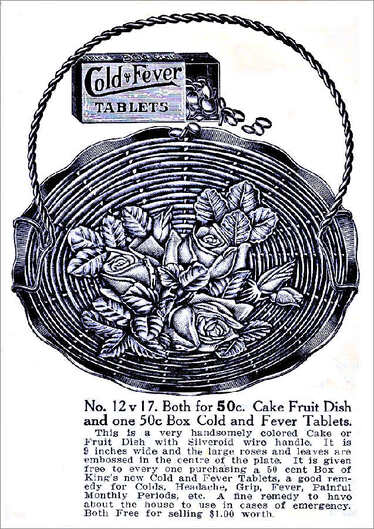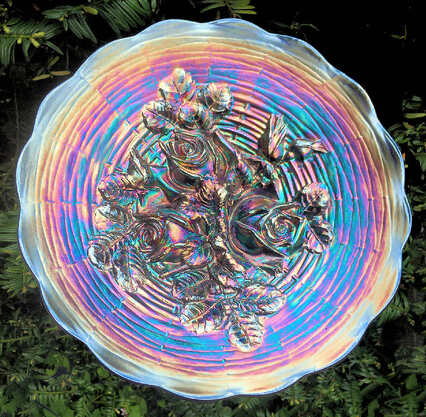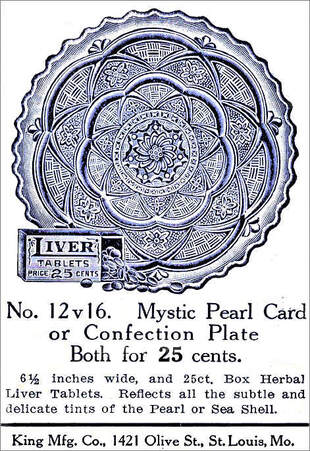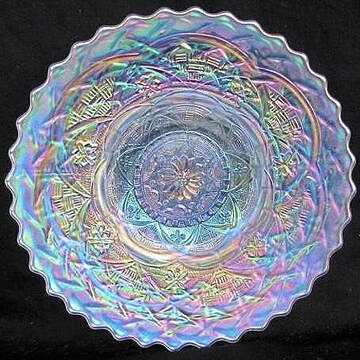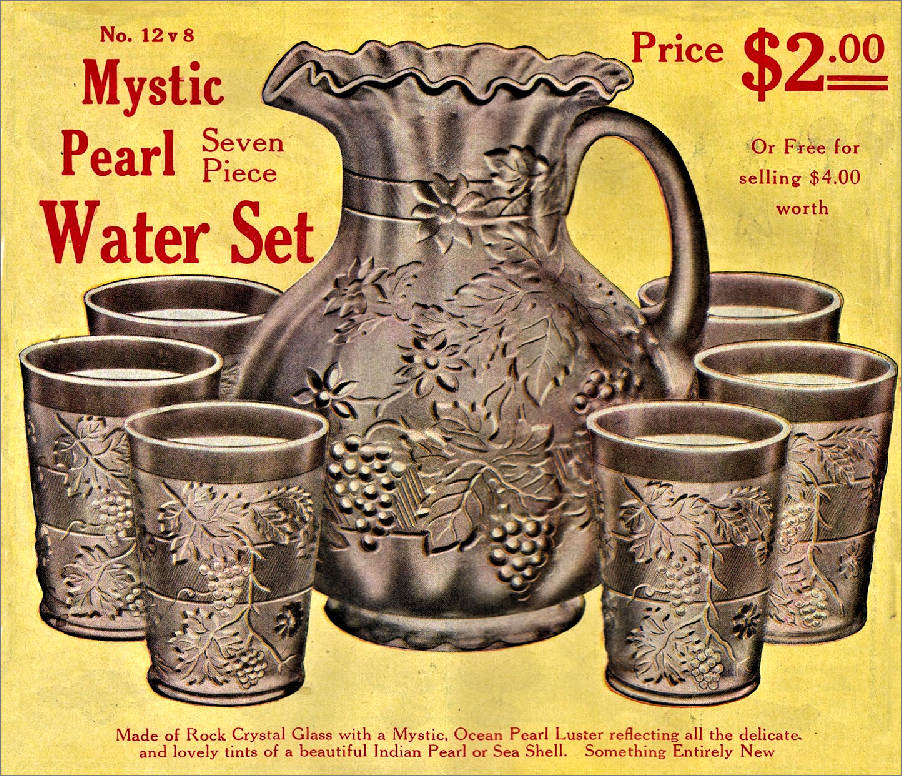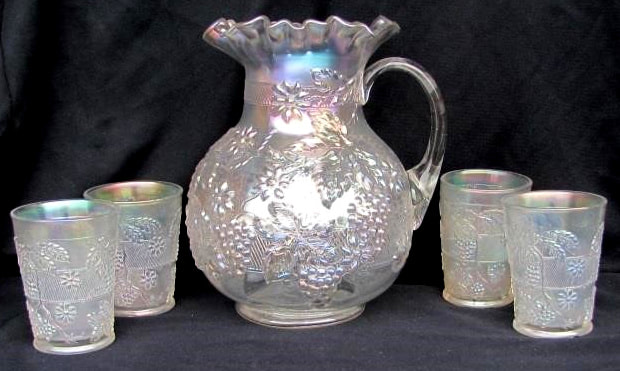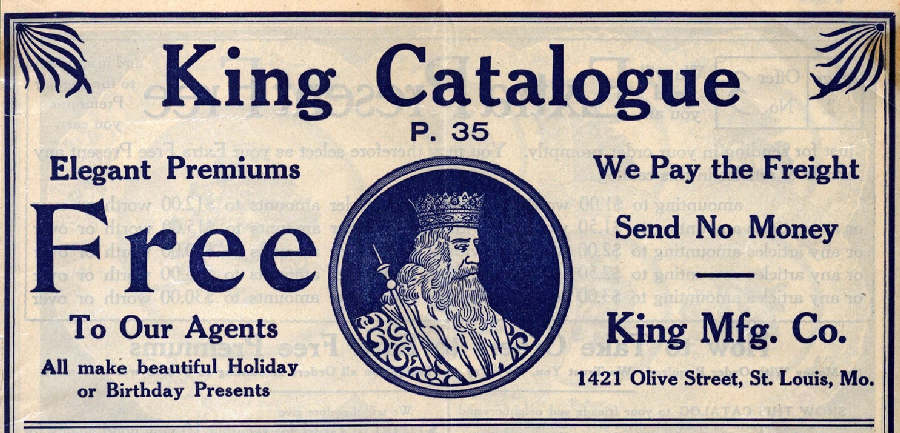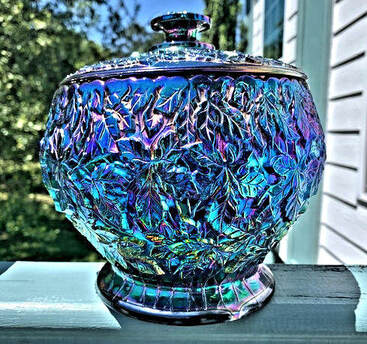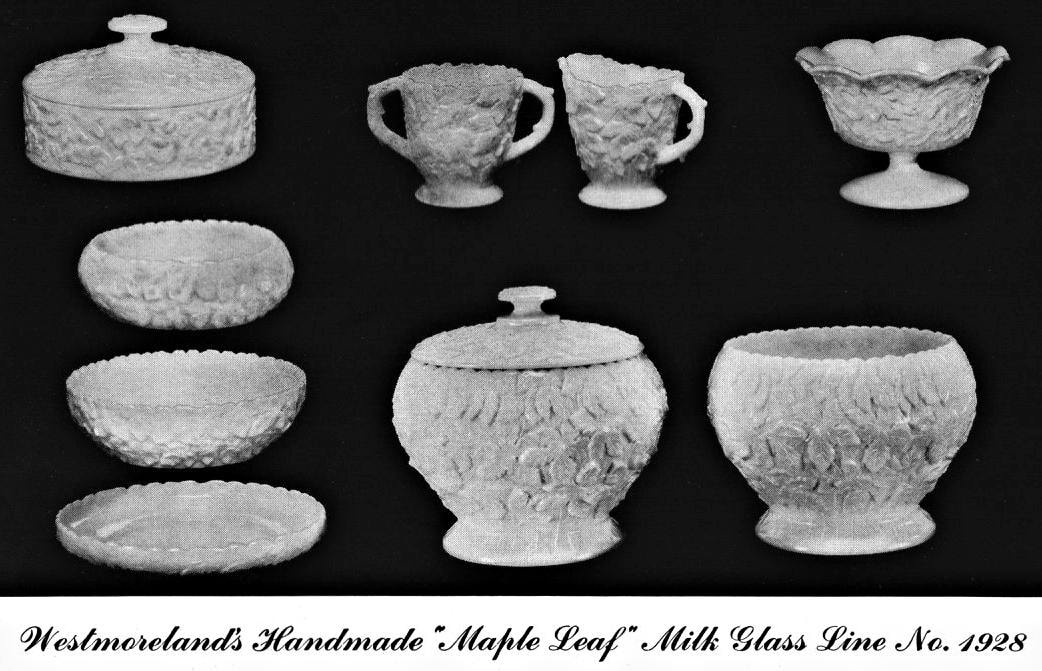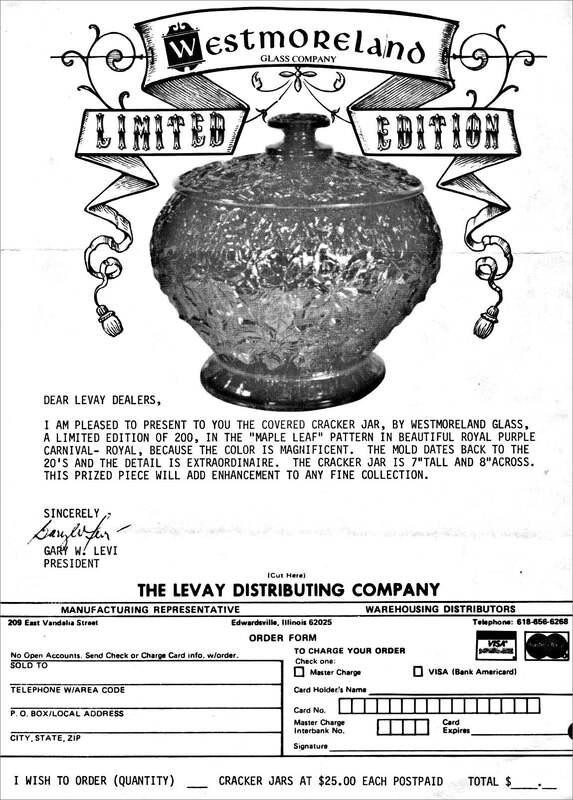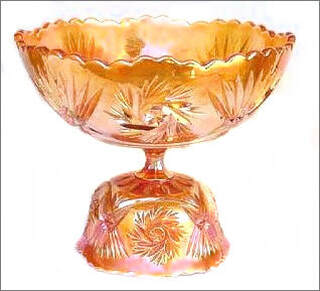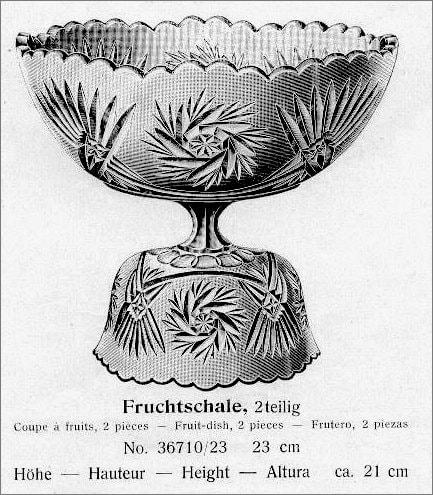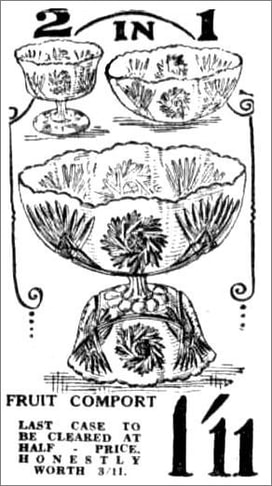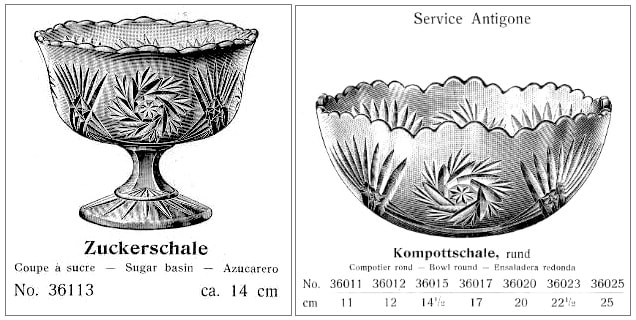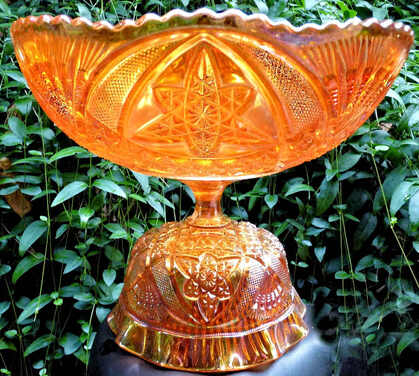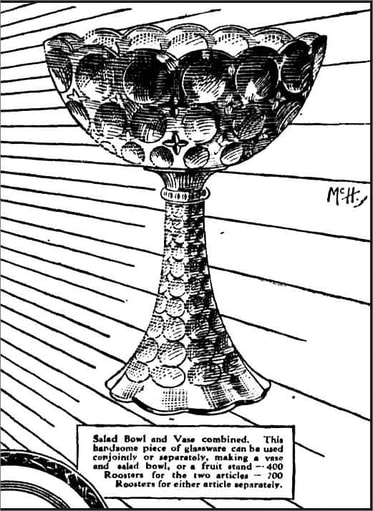NetworK ezine Issue 97. June 2023
Totally Devoted to Carnival Glass
Welcome to the June edition of Carnival Glass NetworK.
In the previous issue we began with the iconic Northwood pattern Poppy Show – in this one we start with its “sister” pattern, the magnificent Rose Show.
In the previous issue we began with the iconic Northwood pattern Poppy Show – in this one we start with its “sister” pattern, the magnificent Rose Show.
As in Poppy Show, the Rose Show flowers seem almost sculpted – raised up from the surface of the glass in a breath-takingly realistic manner. It’s a sought-after pattern, especially in the plate form, so it came as a real surprise to see Northwood’s Rose Show plate being offered as a free gift to sales agents in 1912 in the catalogue of the King Manufacturing Company. Let’s see what it was all about …
The 1912 ad shown above is fascinating on so many levels, not the least being the beauty and quality of the illustration itself. The Rose Show plate is depicted in a wire holder – the sort that transforms a bowl or plate into what was surely considered back in 1912 as a much fancier item. Today we grimace at the idea of clamping metal around the vulnerable sides of a glorious glass plate, and there’s no doubt that these wire handle holders surely damaged many a once-pristine item. But clearly in 1912 it was "de rigueur". Note that the wire holder was described as “Silveroid” – silver in appearance but not in fact. And all you had to do to acquire the plate was purchase a box of “Cold and Fever Tablets” for 50 cents *. Even better if you were an agent and chalked up a dollar’s worth of sales, in which case you would get not only the Rose Show plate, but also the medication – both free of charge!
The King Manufacturing Co. operated a premium plan business, using agents to sell the goods in their catalogues.
The King Manufacturing Co. operated a premium plan business, using agents to sell the goods in their catalogues.
|
The goods would be sent to their agents by free shipping (as Kings said “We bear the expense of freight charges”) and the payments would be collected and submitted to the parent company. Agents would be compensated by receiving free goods (premiums) and/or a cash commission. You can read more about them in previous editions of NetworK – link at the end of this section. On the immediate right is another splendid offer in the 1912 King Catalogue – a Dugan Persian Garden 6.5 inch plate. Just collect it along with your box of Herbal Liver Tablets for 25 cents! Again, the catalogue artwork is exceptional, and the detailed rendition of the pattern is a delight. But what caught our eye even more was the name of the colour – “Mystic Pearl”. This is, of course, what we know as white Carnival. |
Above: Persian Garden 6.5 inch plate in white.
Courtesy Burns Auctions. Left: extract from the 1912 King Manufacturing Co. Catalogue of Goods and Premiums featuring a Dugan Persian Garden plate. Courtesy Jon D Bartell and the Glass Paper Fanatics. |
Northwood had introduced his pastel shades in January 1912 (you can read all about it in our previous NetworK issue 65) – but it appears that his cousin Tom Dugan, had brought out white Carnival prior to that date. What’s the evidence for this claim? A most interesting report in Thomas Dugan’s notebook from 1909 (see “Dugan/Diamond” Heacock, Measell, Wiggins) describes “white” or “pearl” that was made by spraying a dope of tin crystals (stannous chloride) on hot glass. Now add to this the fact that Dugan’s white Carnival (“Mystic Pearl”) was being promoted as premiums in a 1912 jobber’s catalogue, and it’s clear that this colour had surely been in the Dugan line for a little while previously.
Here is more “Mystic Pearl” – a white Carnival Floral and Grape water set from Dugan – it was also heavily promoted in the 1912 King Catalogue. Note the fanciful description underneath the illustration: “Made of Rock Crystal Glass with a Mystic, Ocean Pearl Luster reflecting all the delicate and lovely tints of a beautiful Indian Pearl or Sea Shell”. Use of the term “Rock Crystal” is interesting. Rock Crystal is clear quartz, but the term was sometimes used to describe clear (crystal) glass.
|
The King Catalogue customers certainly had some beautiful items (“Elegant Premiums”) to choose from. * Historical Note: In June 1906, US President Theodore signed into law the first federal Food and Drug Act. Previously, medicine manufacturers could make any health claims - often exaggerated - for their products. They were not required to state the ingredients, including some that were potentially addictive, or even deadly! The 1906 law required products to state if any of the following ingredients were present: alcohol, morphine, opium, cocaine, heroin, eucaine, chloroform, cannabis indica, chloral hydrate, or acetanilide (a complete listing of all ingredients was not required until 1938). |
Further Reading
Floral and grape: NetworK #85
Northwood introduces Pastels: NetworK #64
King Manufacturing Company: NetworK #78 and NetworK #69
Floral and grape: NetworK #85
Northwood introduces Pastels: NetworK #64
King Manufacturing Company: NetworK #78 and NetworK #69
Westmoreland Maple Leaf
When Tim Lear posted his amazing new find in our Carnival NetworK Facebook group, we were blown away by its beauty.
The pattern was named “Maple Leaf” by Westmoreland (aka “Bramble”) and it was their No. 1928 line. The shape was described as a cookie jar and cover in Westmoreland’s catalogue. The pattern was first produced by Westmoreland in the 1920s; subsequently the line was extended, different shapes were added and it was produced widely in milk glass in the 1950s.
|
Above: Maple Leaf covered cookie jar in Royal Purple.
Courtesy and Copyright Tim Lear. Above: extract from Westmoreland’s Catalogue 163, from 1952,
showing some of the items in their Maple Leaf pattern. The cookie jar was described as “No. 1928/8” Maple Leaf Cookie Jar and Cover 7¼ inches tall. Courtesy Glass Paper Fanatics. |
Above: during the Carnival Revival era, the potential for this beauty to be showcased in Carnival Glass was noted by Gary Levi of The Levay Distributing Company. This is a copy of Levay's 1980 promotional leaflet for the Limited Edition of the Maple Leaf item that was made for them by Westmoreland. (Note that the shape is called a cracker jar in the Levay promo, whereas Westmoreland had previously called it a cookie jar.)
|
Post Script: The moulds for the Maple Leaf line went to Plum Glass in the 1980s and then to Fenton. Subsequently at least one mould (the vase) was sold to Glass Eye Studio who produced it in 2018 in blue Carnival and possibly other colours.
|
So That’s How It’s Done!
Take a stemmed sugar bowl and turn it upside down (make sure you’ve removed the sugar first). Then get your bowl and fit it neatly on top of the upturned sugar and hey presto, you have a fancy centrepiece fruit dish, fit to grace any fine dining table. Brockwitz was proficient at designing items that could be adapted and extended in this way. |
|
Far left: a "Zuckerschale" (stemmed sugar) and on its right is a "Kompottschale" (round bowl). Invert the sugar, put the bowl on top - the foot of the the sugar fits perfectly into the depressed marie on the base of the bowl - and you have a "Fruchtschale"! The "Kompottschale" / fruit bowl was made in several sizes, but we are unsure if all sizes were done in Carnival. |
The catalogue images of the three Antigone items shown here are from the Brockwitz 1931 catalogue. It is interesting to see that the catalogue was in four languages: German (for the company's home market), plus French, English and Spanish (for its exports).
|
Brockwitz Curved Star (OMN Zurich) items can also be used in exactly this same manner, with the bowl sitting on top of an upturned stemmed sugar, as in this photo below. Another way to combine two Brockwitz items was shown in the Australian press in 1929, although it was probably not for the faint-hearted. A marigold Moonprint (OMN Globus) bowl was fitted on top of an upturned Moonprint trumpet vase to create a stunningly impressive centrepiece.
You can read more about this and see the glass itself in our Carnival NetworK #54, here: NetworK #54 |
Extract from 1929 ad for Roosters, in the Sydney Sun.
Courtesy of the National Library of Australia Digitised Newspapers. |
Privacy and the use of your information: we only use your name and email address to send you your Carnival Glass NetworK ezine. We will not share your name or email address with anyone else, or use it for any other purpose. You can change your mind about receiving your NetworK ezine at any time by clicking the unsubscribe link at the foot of every issue, or by emailing us at [email protected]
Join us on Facebook
We invite you and your friends to join us all on NetworK's fast growing and very active Facebook Group (link is below), and if you have missed any of the previous issues of NetworK and NetworK Specials, they are all here: Back Issues.
We invite you and your friends to join us all on NetworK's fast growing and very active Facebook Group (link is below), and if you have missed any of the previous issues of NetworK and NetworK Specials, they are all here: Back Issues.

